Re-Defining System LCOE: Costs and Values of Power Sources
Abstract
1. Introduction
1.1. Mass Introdcution of Variable Renewable Energies and Associated Challenges
1.2. Literature Review: High Penetration of VRE and Integration Cost
1.3. Literature Review: Costs/Values of Power Sources and Proposed Metrics “beyond LCOE”
2. Theoretical Background and Methodology
2.1. Metrics Proposed in the Previous Study
2.1.1. Relative Marginal System LCOE
2.1.2. Average System LCOE
2.2. Additional Definitions and Discussions over the Metrics
2.2.1. Mathematical Formulation
2.2.2. A New Metric—Marginal System LCOE and “Separability”
2.2.3. The Effect of Demand Flexibility
2.2.4. Comparison with System LCOE_HUE
2.2.4.1. Discussion over Separability
2.2.4.2. Setting Constraints and Changes in the Total Power Generation
- Case A: Constrain coal power output to achieve the VRE share.
- Case B: Constrain wind power output to achieve the VRE share.
- Case C: Constrain the VRE share itself.
2.3. Calculations for a Real System: Japan’s Decarbonised Power Sector in 2050
- Japan is regarded as one region, or divided into three (Hokkaido, Tohoku, and other areas) or five (Hokkaido, Tohoku, Tokyo, Western Japan excluding Kyushu, and Kyushu) regions, rather than the nine regions in Matsuo et al. (2018) [19].
- The calculations focus on five types of power generation: Zero-emission thermal, nuclear, onshore wind, offshore wind, and solar PV. Power output from other technologies (hydro, geothermal, and biomass) are fixed and subtracted from power demand in advance of the calculations. The zero-emission thermal power generation in region 3, including Tokyo, with an LCOE of 11.2 JPY/kWh at the maximum load factor of 80%, is adopted as the reference technology.
- A model with an hourly resolution, rather than one with a 10-min resolution, is used, only for simplicity.
- The “lower” and the “medium” cost assumptions in Matsuo et al. (2018) [19] are used for renewables and zero-emission thermal power, respectively. Hydrogen storage is also allowed, along with lithium-ion batteries.
3. Results and Discussion
3.1. Three- and Five-Regional Models
3.2. Effect of Demand Flexibility and Meteorological Condition
4. Conclusions
Funding
Institutional Review Board Statement
Informed Consent Statement
Data Availability Statement
Conflicts of Interest
Appendix A. Additional Discussion on System LCOE_HUE: Costs and Values

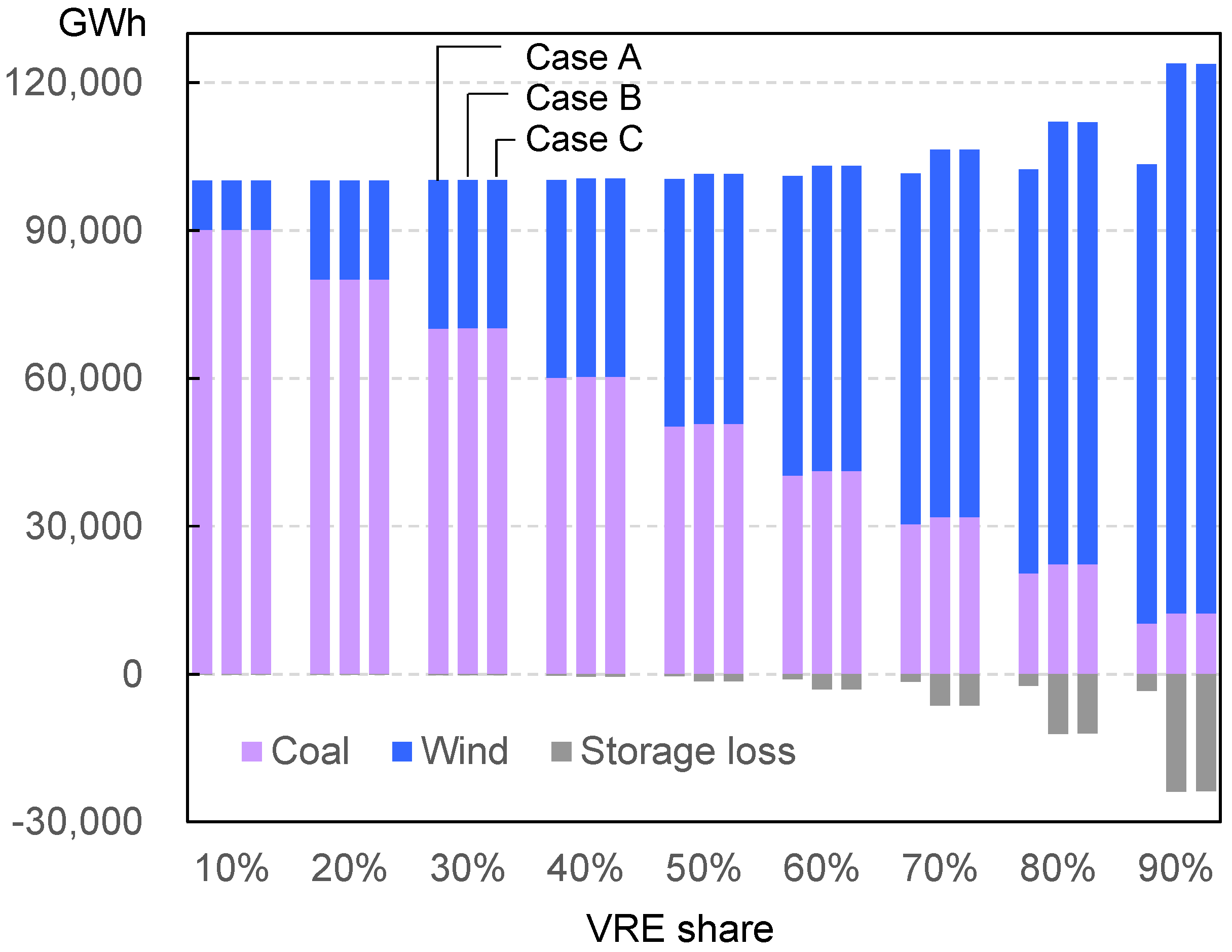
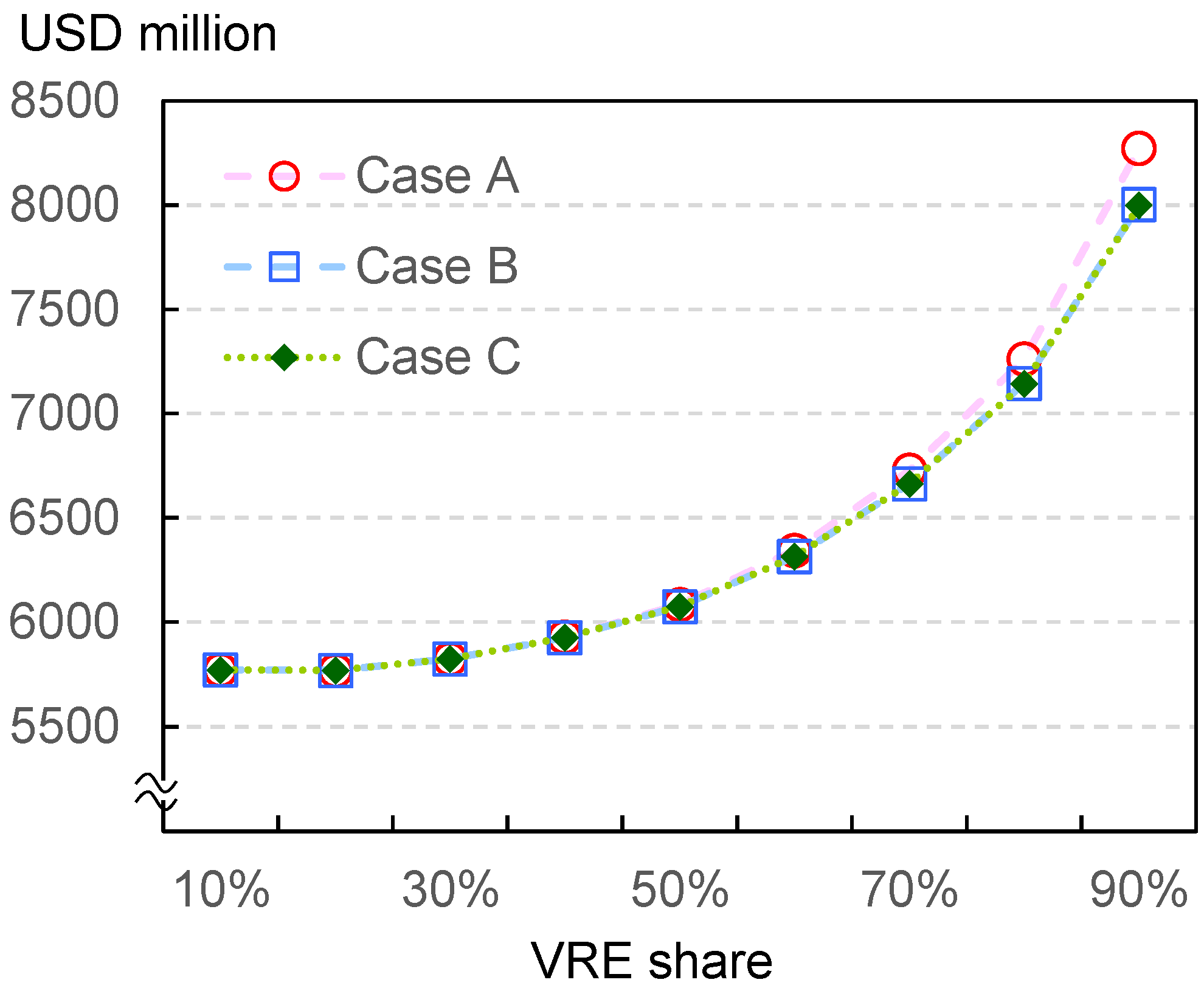

Appendix B. Re-Defining System LCOE—A Simple Case with Two Technologies
Appendix B.1. System LCOE and Optimization of the Power Sector
Appendix B.2. Average System LCOE: Allocation of the Integration Cost

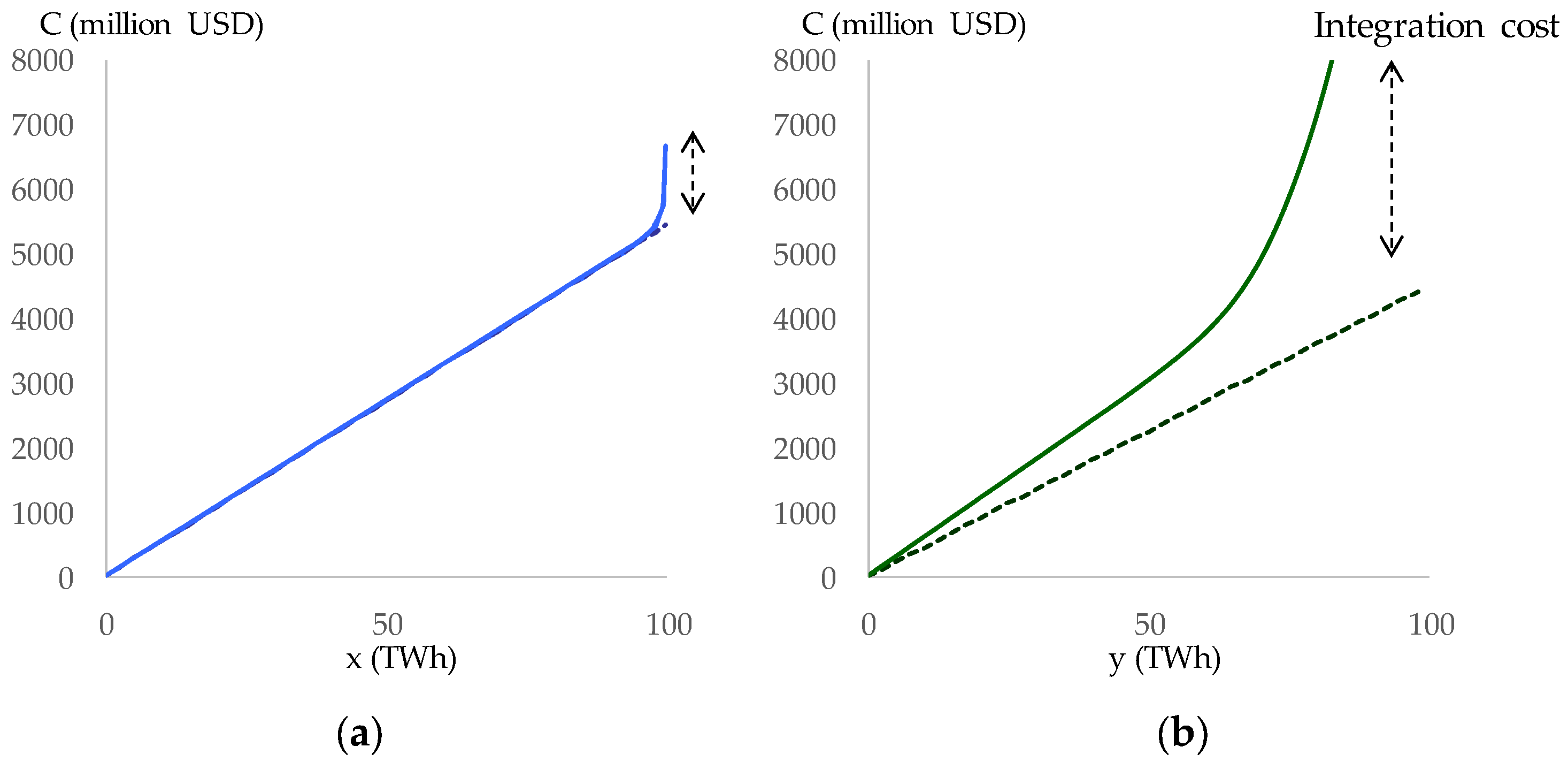
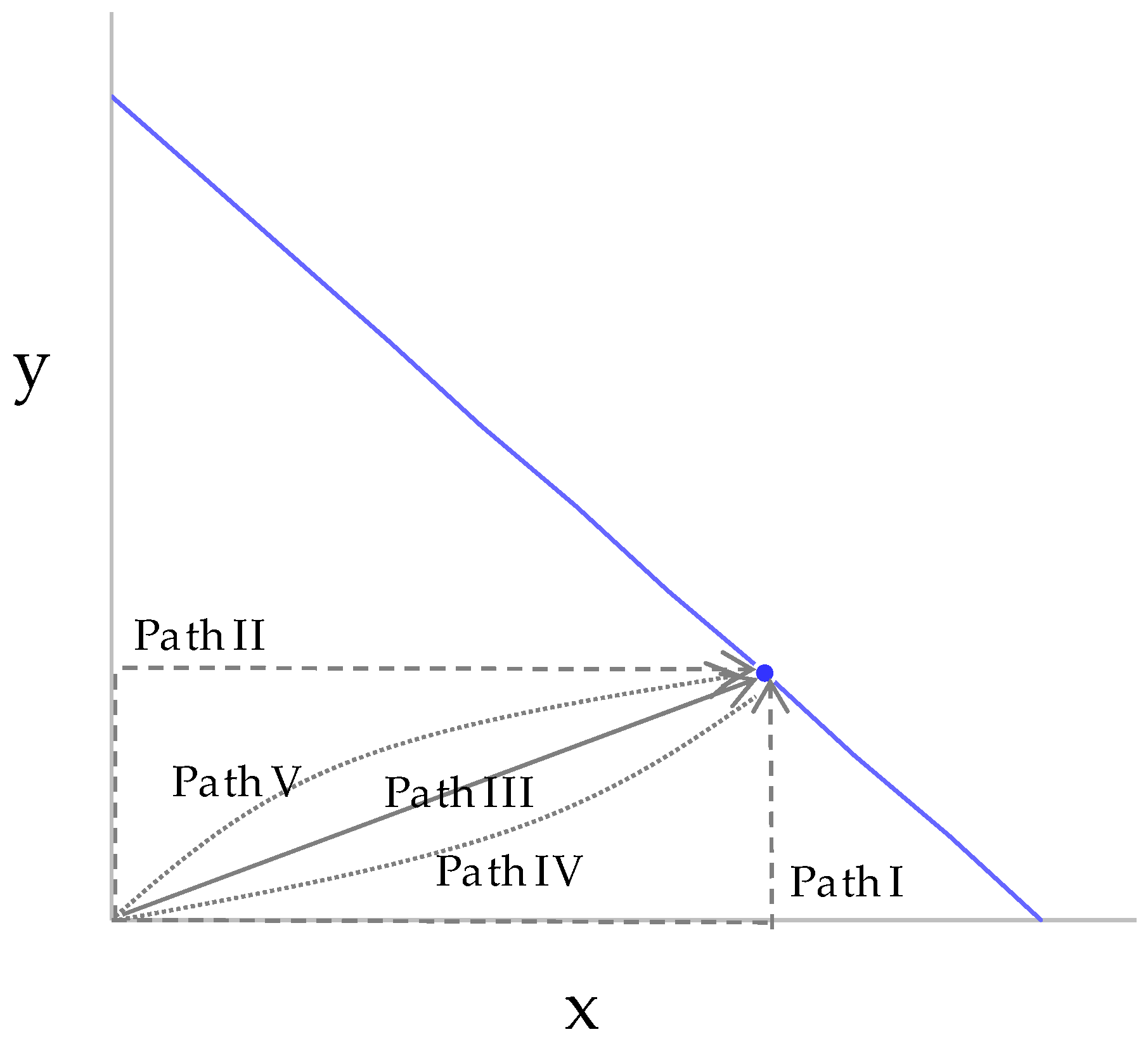

Appendix C. Re-Defining System LCOE—General Case with Multiple Technologies and Electricity Losses
Appendix C.1. Relative Marginal System LCOE
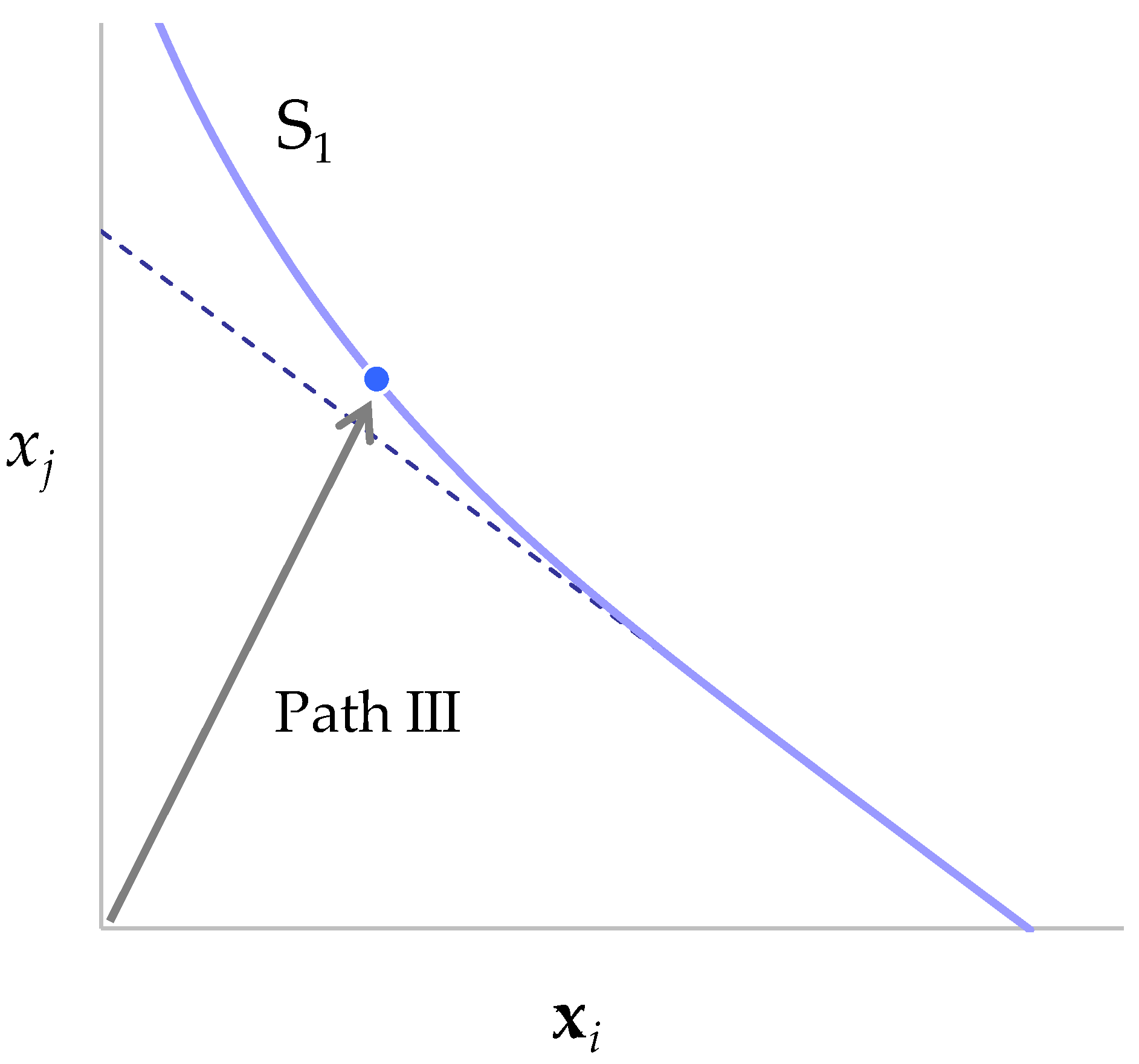
Appendix C.2. Average System LCOE
Appendix C.3. Marginal System LCOE
Appendix D. A Simple Model with Two Technologies
| Symbols | Description |
|---|---|
| ,
, | Annual and hourly electricity output of the conventional technology, VRE, and the costless technology |
| ut | VRE curtailment at time t |
| ct, dt, st | Electricity charge, discharge, and stored electricity at time t |
| Kx, Ky, Ks | kW and kWh capacities of the conventional technology, VRE, and the storage system |
| Symbols | Description |
|---|---|
| dt | Electricity demand at time t |
| wt | Output ratio of VRE at time t |
| lf = 0.8 | Maximum load factor of the conventional technology |
| ef = 0.85 or 1 | Cycle efficiency of the battery |
| cr = 0.3 | Capacity credit of VRE |
| sr = 0.5 | kW/kWh ratio of the battery |
| r = 0.08 | Reserve margin |
| Symbols | Description |
|---|---|
| VCx = 0.03 | Variable cost of the conventional technology, USD/kWh |
| FCx = 171.01 | Fixed cost of the conventional technology, USD/kW/yr |
| FCy = 86.74 | Fixed cost of VRE, USD/kW/yr |
| FCs = 9.17 | Fixed cost of the storage system, USD/kW/yr |
- Supply and demand balance constraint
- 2.
- Power charge and discharge balance constraint
- 3.
- Capacity limitation
- 4.
- Load factor limitation
- 5.
- Capacity credit constraint
References
- Intergovernmental Panel on Climate Change (IPCC). Global Warming of 1.5 °C. 2018. Available online: https://www.ipcc.ch/sr15 (accessed on 15 August 2022).
- International Energy Agency (IEA). WEO-2015 Special Report: Energy and Climate Change. 2015. Available online: https://webstore.iea.org/weo-2015-special-report-energy-and-climate-change (accessed on 15 August 2022).
- European Commission. Energy Roadmap 2050; Publications Office of the European Union: Luxembourg, 2012. Available online: https://ec.europa.eu/energy/sites/ener/files/documents/2012_energy_roadmap_2050_en_0.pdf (accessed on 15 August 2022).
- Organisation for Economic Co-Operation and Development/Nuclear Energy Agency (OECD/NEA). Full Costs of Energy Provision; OECD Publishing: Paris, France, 2018. [Google Scholar]
- Organisation for Economic Co-Operation and Development/Nuclear Energy Agency (OECD/NEA); International Energy Agency (IEA). Projected Costs of Generating Electricity 2020 Edition; OECD Publications: Paris, France, 2020. [Google Scholar]
- McCann, R. Comment: LCOE is an undiscounted metric that distorts comparative analyses of energy costs. Electr. J. 2020, 33, 106812. [Google Scholar] [CrossRef]
- Nissen, U.; Harfst, N. Shortcomings of the traditional “levelized cost of energy” [LCOE] for the determination of grid parity. Energy 2019, 171, 1009–1016. [Google Scholar] [CrossRef]
- Bruck, M.; Sandborn, P. Pricing bundled renewable energy credits using a modified LCOE for power purchase agreements. Renew. Energy 2021, 170, 224–235. [Google Scholar] [CrossRef]
- Belderbos, A.; Delarue, E.; Kessels, K.; D’haeseleer, W. Levelized cost of storage—Introducing novel metrics. Energy Econ. 2017, 67, 287–299. [Google Scholar] [CrossRef]
- Mostafa, M.H.; Aleem, S.H.E.; Ali, S.G.; Ali, Z.M.; Abdelaziz, A.Y. Techno-economic assessment of energy storage systems using annualized life cycle cost of storage (LCCOS) and levelized cost of energy (LCOE) metrics. J. Energy Storage 2020, 29, 201345. [Google Scholar] [CrossRef]
- Ueckerdt, F.; Brecha, R.; Luderer, G.; Sullivan, P.; Schmid, E.; Bauer, N.; Böttger, D.; Pietzcker, R. Representing power sector variability and the integration of variable renewables in long-term energy-economy models using residual load duration curves. Energy 2015, 90, 1799–1814. [Google Scholar] [CrossRef]
- McPherson, M.; Johnson, N.; Strubegger, M. The role of electricity storage and hydrogen technologies in enabling global low-carbon energy transitions. Appl. Energy 2018, 216, 649–661. [Google Scholar] [CrossRef]
- Ueckerdt, F.; Pietzcker, R.; Scholz, Y.; Stetter, D.; Giannousakis, A.; Luderer, G. Decarbonizing global power supply under region-specific consideration of challenges and options of integrating variable renewables in the REMIND model. Energy Econ. 2017, 64, 665–684. [Google Scholar] [CrossRef]
- International Energy Agency (IEA). World Energy Model Documentation. 2021. Available online: https://www.iea.org/reports/world-energy-model (accessed on 14 September 2022).
- International Energy Agency (IEA). World Energy Outlook 2021; International Energy Agency: Paris, France, 2021. [Google Scholar]
- Hirth, L.; Ueckerdt, F.; Edenhofer, O. Why wind is not coal: On the economics of electricity. Energy J. 2016, 37, 1–27. [Google Scholar] [CrossRef]
- Reichenberg, L.; Hedenus, F.; Odenberger, M.; Johnsson, F. The marginal system LCOE of variable renewables—Evaluating high penetration levels of wind and solar in Europe. Energy 2018, 152, 914–924. [Google Scholar] [CrossRef]
- Matsuo, Y.; Komiyama, R. System LCOE of variable renewable energies: A case study of Japan’s decarbonized power sector in 2050. Sustain. Sci. 2021, 16, 449–461. [Google Scholar] [CrossRef]
- Matsuo, Y.; Endo, S.; Nagatomi, Y.; Shibata, Y.; Komiyama, R.; Fujii, Y. A quantitative analysis of Japan’s optimal power generation mix in 2050 and the role of CO2-free hydrogen. Energy 2018, 165, 1200–1219. [Google Scholar] [CrossRef]
- Matsuo, Y.; Endo, S.; Nagatomi, Y.; Shibata, Y.; Komiyama, R.; Fujii, Y. Investigating the economics of the power sector under high penetration of variable renewable energies. Appl. Energy 2020, 267, 113956. [Google Scholar] [CrossRef]
- Power Generation Costs Analysis Working Group (PGCA-WG). A Report to the Basic Policy Subcommittee on the Verification of Power Generation Costs. 2021. Available online: https://www.enecho.meti.go.jp/committee/council/basic_policy_subcommittee/mitoshi/cost_wg/pdf/cost_wg_20210908_01.pdf (accessed on 15 August 2022).
- Department for Business, Energy & Industrial Strategy (BEIS). BEIS Electricity Generation Costs (2020). 2020. Available online: https://www.gov.uk/government/publications/beis-electricity-generation-costs-2020 (accessed on 15 August 2022).
- Ueckerdt, F.; Hirth, L.; Luderer, G.; Edenhofer, O. System LCOE: What are the costs of variable renewables? Energy 2013, 63, 61–75. [Google Scholar] [CrossRef]
- Jacobson, M.Z.; Delucchi, M.A.; Bazouin, G.; Bauer, Z.A.F.; Heavey, C.C.; Fisher, E.; Morris, S.B.; Piekutowski, D.J.Y.; Vencill, T.A.; Yeskoo, T.W. 100% clean and renewable wind, water, and sunlight (WWS) all-sector energy roadmaps for the 50 United States. Energy Environ. Sci. 2015, 8, 2093–2117. [Google Scholar] [CrossRef]
- Noel, L.; Brodie, J.F.; Kempton, W.; Archer, C.L.; Budischak, C. Cost minimization of generation, storage, and new loads, comparing costs with and without externalities. Appl. Energy 2017, 189, 110–121. [Google Scholar] [CrossRef]
- Scholz, Y.; Gils, H.C.; Pietzcker, R.C. Application of a high-detail energy system model to drive power sector characteristics at high wind and solar shares. Energy Econ. 2017, 64, 568–582. [Google Scholar] [CrossRef]
- Van Zuijlen, B.; Zappa, W.; Turkenburg, W.; Van der Schrier, G.; Van den Broek, M. Cost-optimal reliable power generation in a deep decarbonisation future. Appl. Energy 2019, 253, 113587. [Google Scholar] [CrossRef]
- Jacobson, M.Z.; Delucchi, M.A.; Cameron, M.A.; Mathiesen, B.V. Matching demand with supply at low cost in 139 countries among 20 world regions with 100% intermittent wind, water, and sunlight (WWS) for all purposes. Renew. Energy 2018, 123, 236–248. [Google Scholar] [CrossRef]
- Ram, M.; Bogdanov, D.; Aghahosseini, A.; Gulagi, A.; Oyewo, S.A.; Child, M.; Caldera, U.; Sadovskaia, K.; Farfan, J.; Barbosa, L.S.N.S.; et al. Global Energy System based on 100% Renewable Energy—Power, Heat, Transport and Desalination Sectors. 2019. Available online: http://energywatchgroup.org/wp-content/uploads/EWG_LUT_100RE_All_Sectors_Global_Report_2019.pdf (accessed on 15 August 2022).
- Liu, H.; Brown, T.; Andresen, G.B.; Schlachtberger, D.P.; Greiner, M. The role of hydro power, storage and transmission in the decarbonization of the Chinese power system. Appl. Energy 2019, 239, 1308–1321. [Google Scholar] [CrossRef]
- Jain, S.; Jain, N.K.; Vaughn, W.J. Challenges in meeting all of India’s electricity from solar: An energetic approach. Renew. Sustain. Energy Rev. 2018, 82, 1006–1013. [Google Scholar] [CrossRef]
- Ogimoto, K.; Urabe, C.T.; Saito, T. Possibilities and issues of renewable energy 100% in a future. Proc. Conf. Energy Econ. Environ. 2018, 34, 697–702. (In Japanese) [Google Scholar]
- Hirth, L.; Ueckerdt, F.; Edenhofer, O. Integration costs revisited—An economic framework for wind and solar variability. Renew. Energy 2015, 74, 925–939. [Google Scholar] [CrossRef]
- Heptonstall, P.; Gross, R.; Steiner, F. The Costs and Impacts of Intermittency—2016 Update. 2017. Available online: http://www.ukerc.ac.uk/programmes/technology-and-policy-assessment/the-costs-andimpacts-of-intermittency-ii.html (accessed on 15 August 2022).
- Organisation for Economic Co-Operation and Development/Nuclear Energy Agency (OECD/NEA). Nuclear Energy and Renewables System Effects in Low-Carbon Electricity Systems; OECD Publications: Paris, France, 2012. [Google Scholar]
- Organisation for Economic Co-Operation and Development/Nuclear Energy Agency (OECD/NEA). The Costs of Decarbonization: System Costs with High Shares of Nuclear and Renewables; OECD Publications: Paris, France, 2019. [Google Scholar]
- Heard, B.P.; Brook, B.W.; Wigley, T.M.L.; Bradshaw, C.J.A. Burden of proof: A comprehensive review of the feasibility of 100% renewable-electricity systems. Renew. Sustain. Energy Rev. 2017, 76, 1122–1133. [Google Scholar] [CrossRef]
- Brown, T.W.; Bischof-Niemz, T.; Blok, K.; Breyer, C.; Lund, H.; Mathiesen, B.V. Response to ‘Burden of proof: A comprehensive review of the feasibility of 100% renewable-electricity systems’. Renew. Sustain. Energy Rev. 2018, 92, 834–847. [Google Scholar] [CrossRef]
- Esteban, M.; Portugal-Pereira, J.; Mclellan, B.C.; Bricker, J.; Farzaneh, H.; Djalilova, N.; Ishihara, K.N.; Takagi, H.; Roeber, V. 100% renewable energy system in Japan: Smoothening and ancillary services. Appl. Energy 2018, 224, 698–707. [Google Scholar] [CrossRef]
- U.S. Energy Information Administration, Department of Energy (U.S.EIA/DOE). Levelized Cost of Electricity and Levelized Avoided Cost of Electricity Methodology Supplement. 2013. Available online: https://www.eia.gov/renewable/workshop/gencosts/pdf/methodology_supplement.pdf (accessed on 13 September 2022).
- U.S. Energy Information Administration, Department of Energy (U.S.EIA/DOE). Levelized Costs of New Generation Resources in the Annual Energy Outlook 2022. 2022. Available online: https://www.eia.gov/outlooks/aeo/pdf/electricity_generation.pdf (accessed on 13 September 2022).
- Idel, R. Levelized full system costs of electricity. Energy 2022, 259, 124905. [Google Scholar] [CrossRef]
- Würzburg, K.; Labandeira, X.; Linares, P. Renewable generation and electricity prices: Taking stock and new evidence for Germany and Austria. Energy Econ. 2013, 40, S159–S171. [Google Scholar] [CrossRef]
- Woo, C.K.; Moore, J.; Schneiderman, B.; Ho, T.; Olson, A.; Alagappan, L.; Chawla, K.; Toyama, N.; Zarnikau, J. Merit-order effects of renewable energy and price divergence in California’s day-ahead and real-time electricity markets. Energy Pol. 2016, 92, 299–312. [Google Scholar] [CrossRef]
- Denny, E.; O’Mahoney, A.; Lannoye, E. Modelling the impact of wind generation on electricity market prices in Ireland: An econometric versus unit commitment approach. Renew. Energy 2017, 104, 109–119. [Google Scholar] [CrossRef]
- Figueiredo, N.C.; Da Silva, P.P. The price of wind power generation in Iberia and the merit-order effect. Int. J. Sustain. Energy Plan. Manag. 2018, 15, 87–96. [Google Scholar]
- Maekawa, J.; Hai, B.H.; Shinkuma, S.; Shimada, K. The effect of renewable energy generation on the electric power spot price of the Japan electric power exchange. Energies 2018, 11, 2215. [Google Scholar] [CrossRef]
- Parajuli, R.; Løkke, S.; Østergaard, P.A.; Knudsen, M.T.; Schmidt, J.H.; Daigaard, T. Life cycle assessment of district heat production in a straw fired CHP plant. Biomass Bioenregy 2014, 68, 115–134. [Google Scholar] [CrossRef]
- Parajuli, R.; Kristensen, I.S.; Knudsen, M.T.; Mogensen, L.; Corona, A.; Birkved, M.; Peña, N.; Graversgaard, M.; Dalgaard, T. Environmental life cycle assessment of producing maize, grass-clover, ryegrass and winter wheat straw for biorefinery. J. Clean. Prod. 2017, 142, 3859–3871. [Google Scholar] [CrossRef]
- Sensfuß, F.; Ragwitz, M.; Genoese, M. The merit-order effect: A detailed analysis of the price effect of renewable electricity generation on spot market prices in Germany. Energy Pol. 2008, 36, 3086–3094. [Google Scholar] [CrossRef]
- International Energy Agency (IEA). Re-Powering Markets—Market Design and Regulation during the Transition to Low Carbon Power Systems; International Energy Agency: Paris, France, 2016. [Google Scholar]
- Hirth, L. The market value of variable renewables: The effect of solar and wind power variability on their relative price. Energy Econ. 2013, 38, 218–236. [Google Scholar] [CrossRef]
- Green, R.J.; Léautier, T.-O. Do Costs Fall Faster than Revenues? Dynamics of Renewables Entry into Electricity Markets. TSE Working Papers. 2015, pp. 15–591. Available online: https://www.tse-fr.eu/sites/default/files/TSE/documents/doc/wp/2015/wp_tse_591.pdf (accessed on 14 September 2022).
- Ministry of the Environment (MOE). Saisei Kanou Enerugi ni Kansuru Zoningu Kiso Jouhou. 2019. Available online: https://www.env.go.jp/earth/zoning/index.html (accessed on 15 August 2022). (In Japanese)
- Iwafune, Y.; Ogimoto, K.; Azuma, H. Integration of electric vehicles into the electric power system based on results of Road Traffic Census. Energies 2019, 12, 1849. [Google Scholar] [CrossRef]
- Organization for Cross-regional Coordination of Transmission Operators, Japan (OCCTO). Keitou Jouhou Sabisu Denki Yohou Kouiki Yobiritsu Web Kouhyou Sisutemu. 2022. Available online: https://www.occto.or.jp/keitoujouhou/ (accessed on 13 September 2022). (In Japanese).
- Matsuo, Y.; Isonaga, A.; Azuma, H.; Fukutome, S.; Iwafune, Y.; Ogimoto, K. A study on the methodology to estimate marginal system LCOE of power sources under high penetration of variable renewable energies. J. Jpn. Soc. Energy Resour. 2022, 43, 129–139. [Google Scholar]

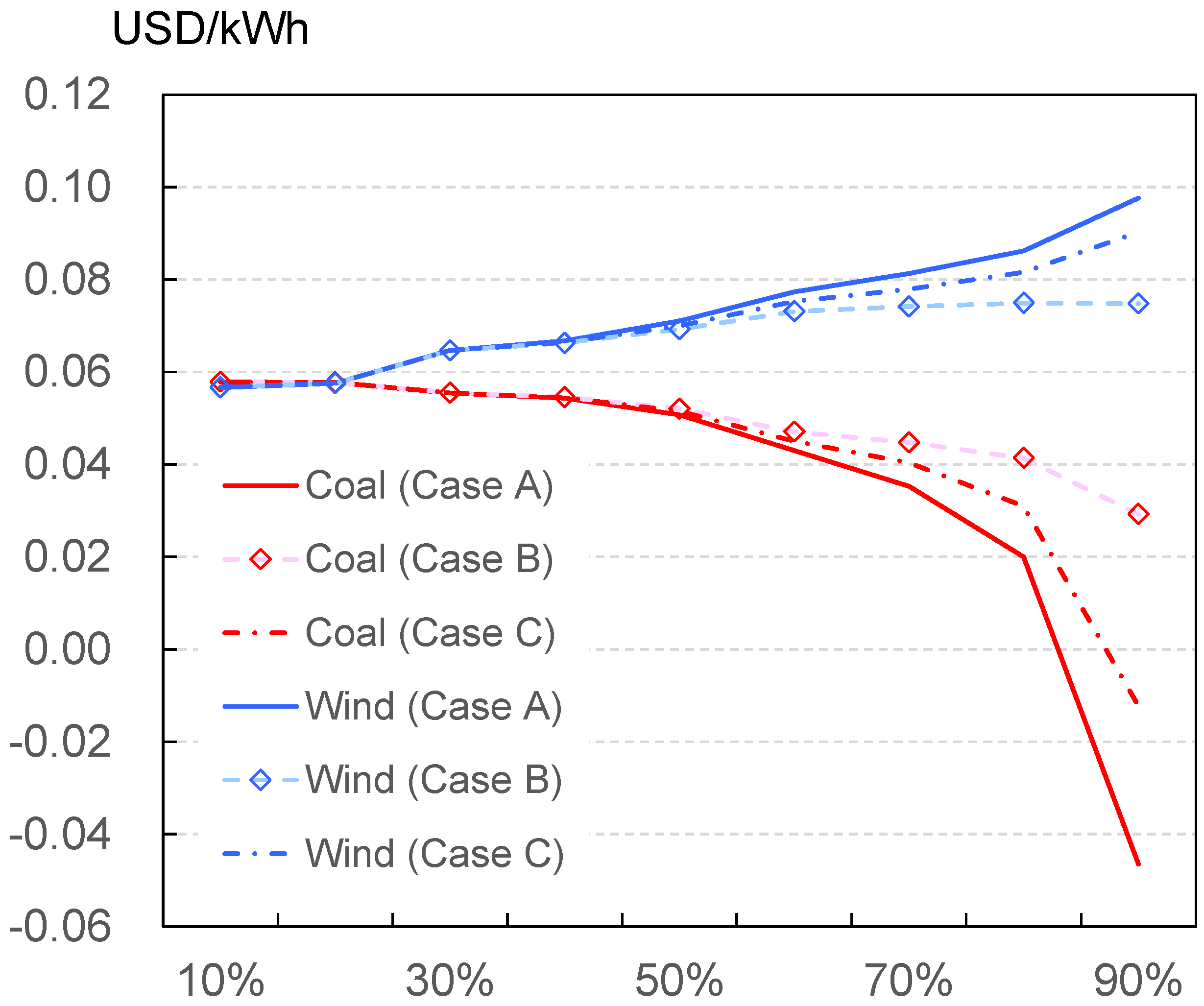
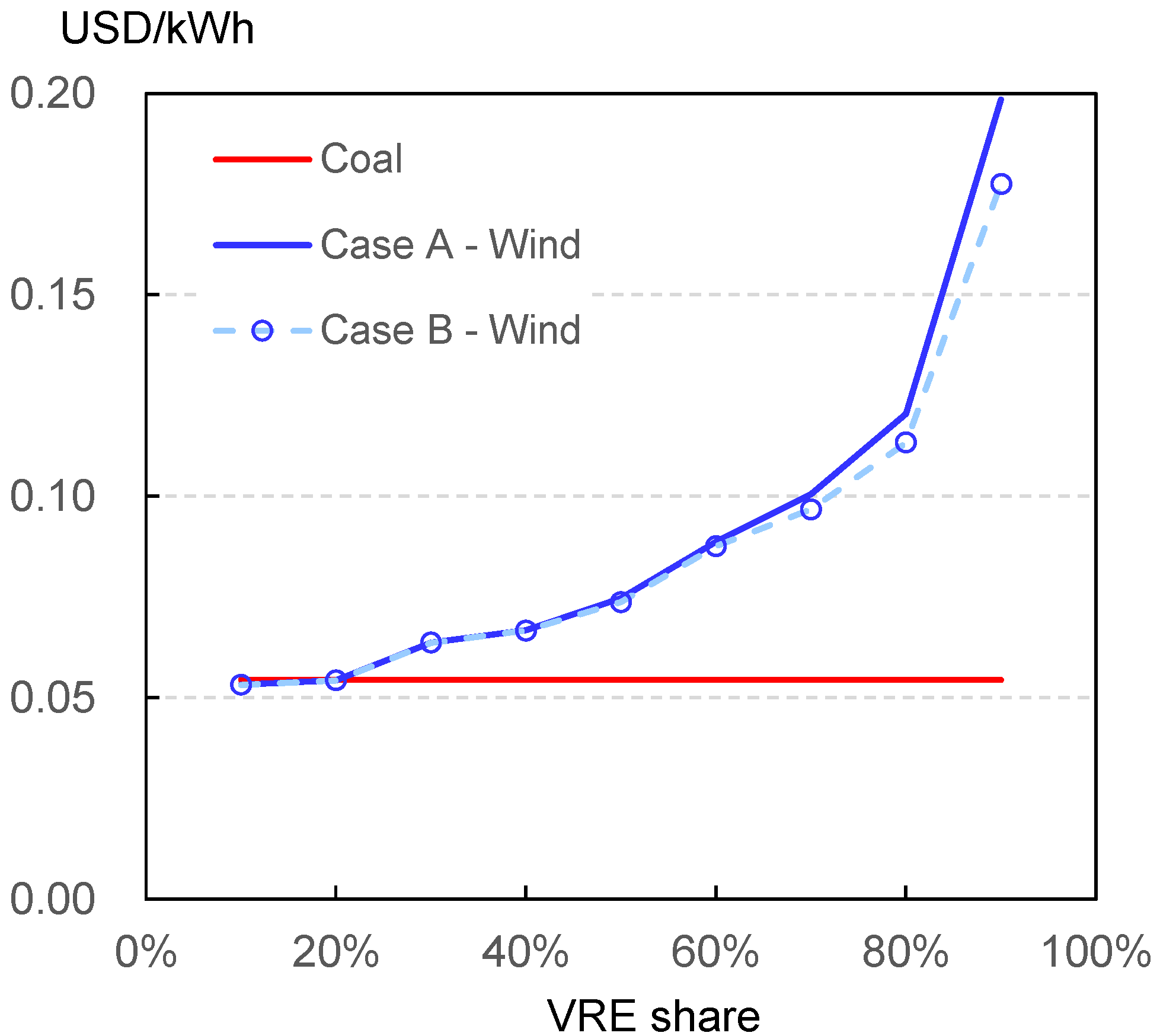
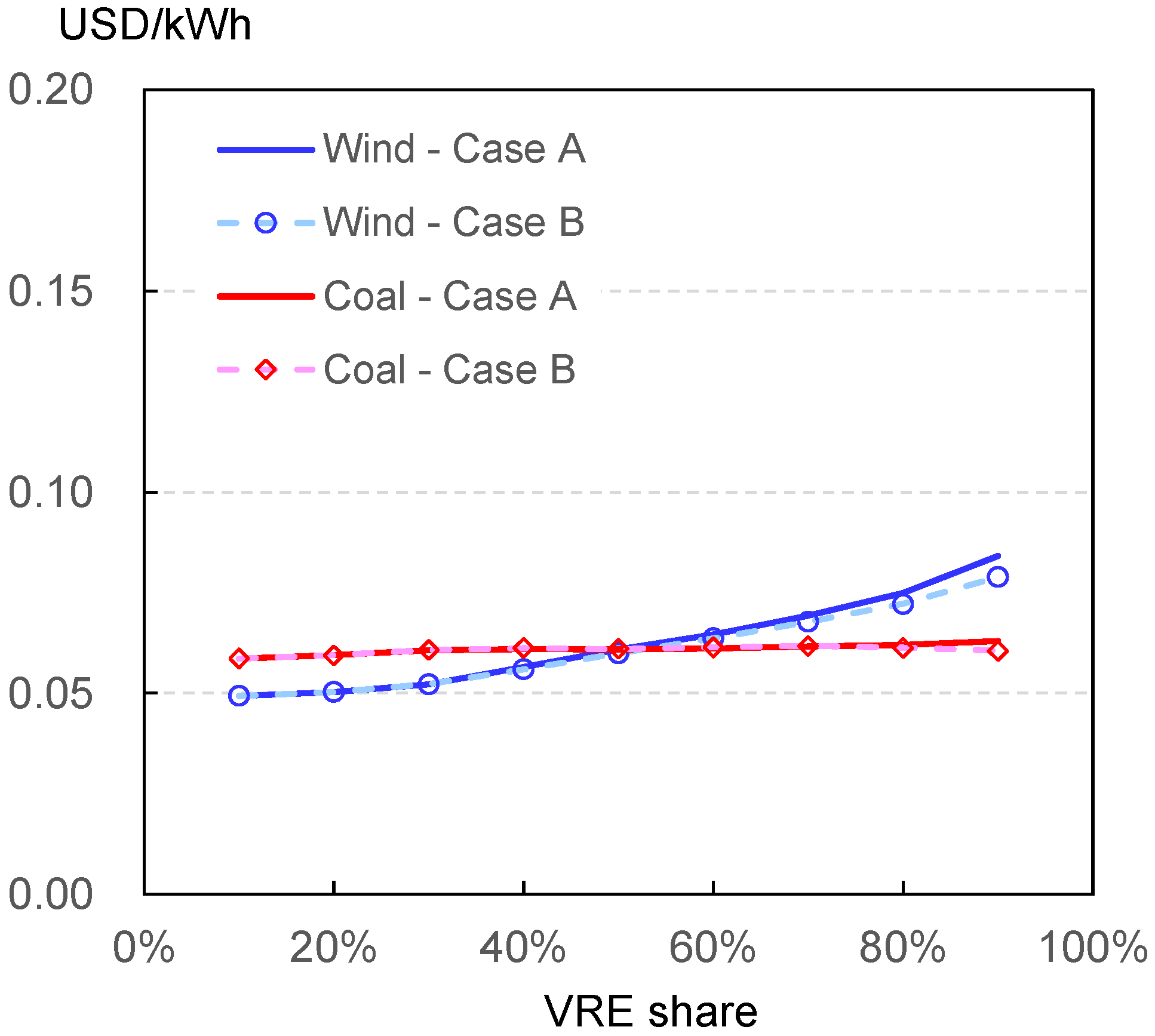
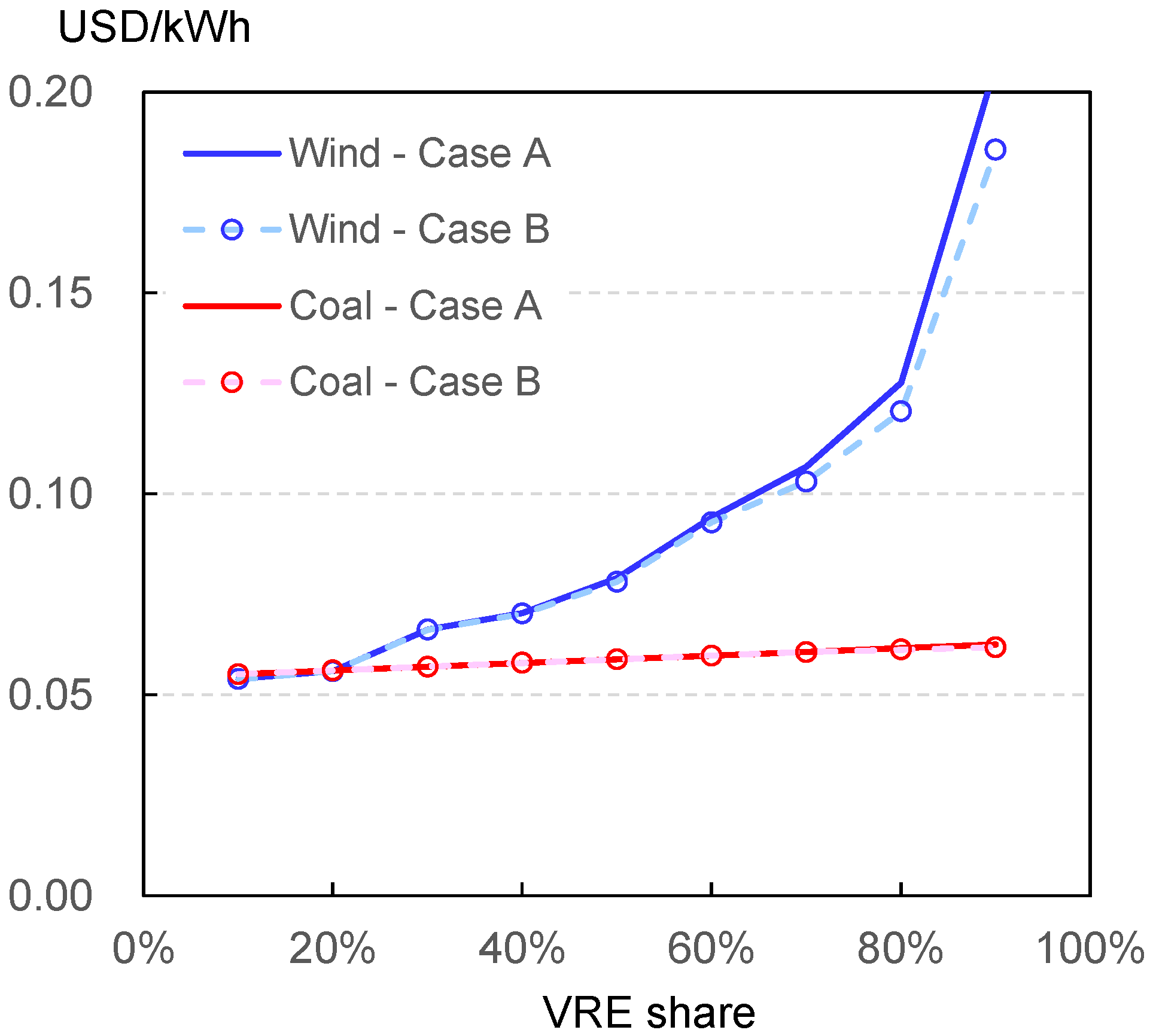
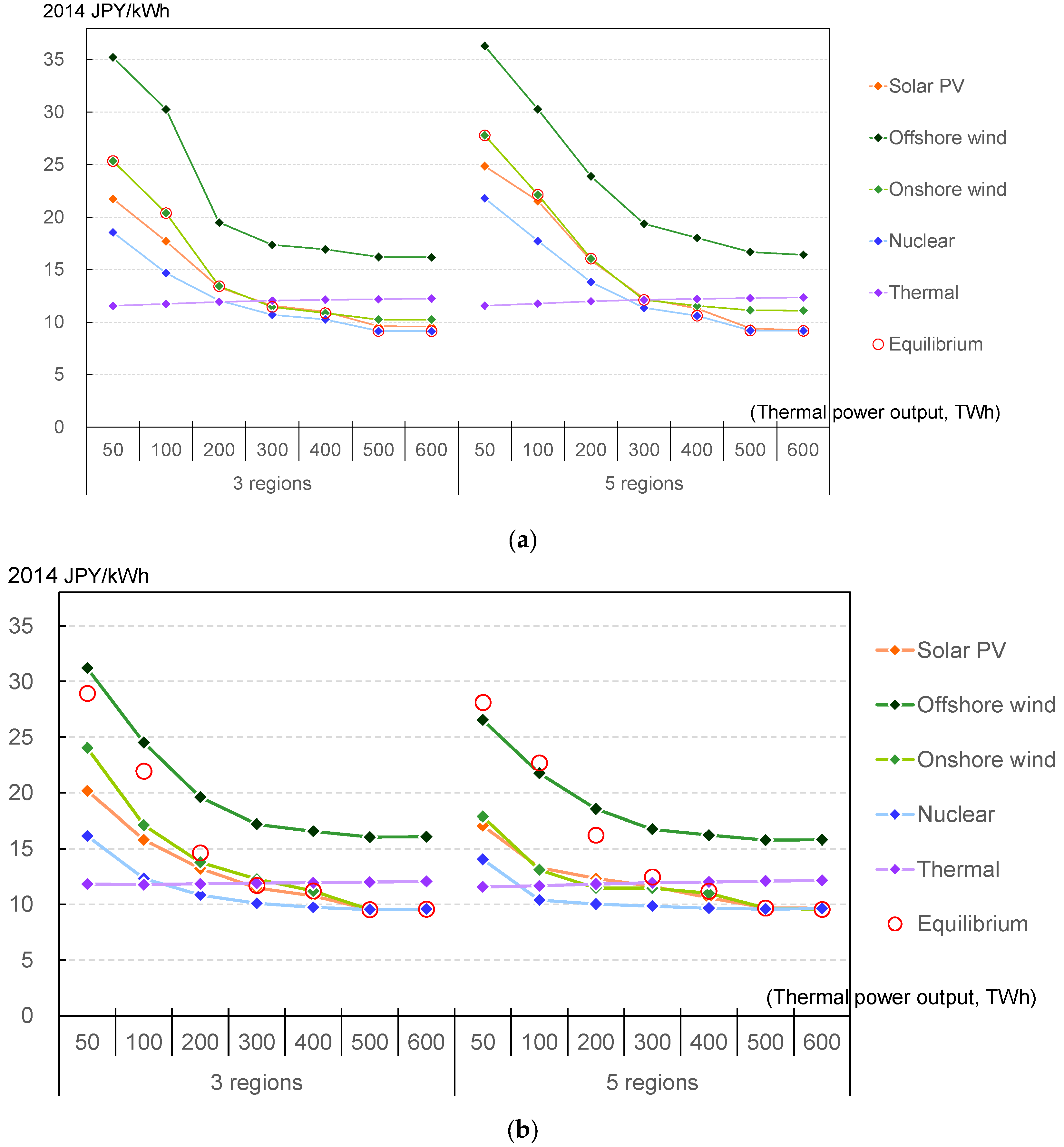
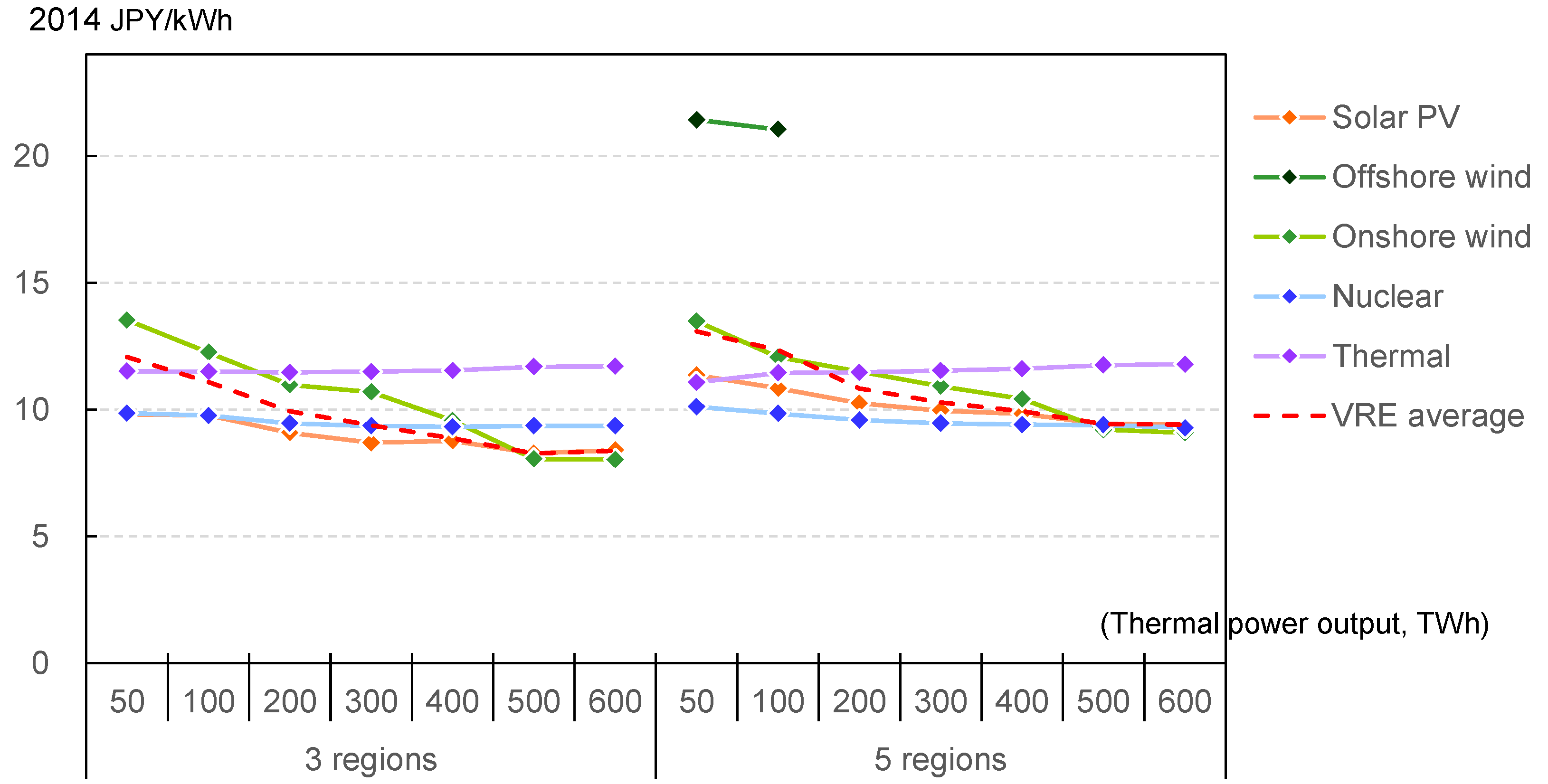
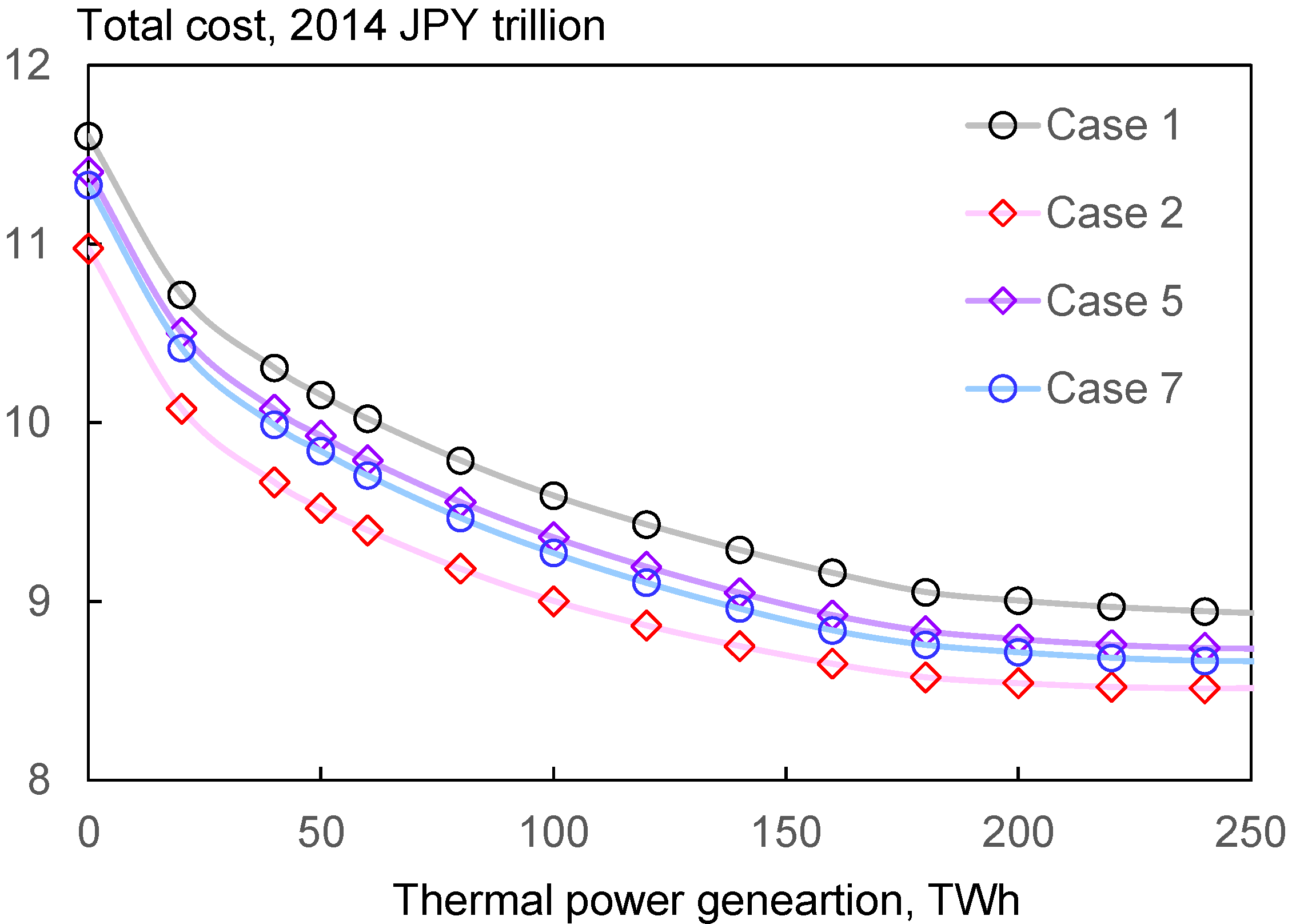
| Case | Meteorological Data | EV Charge | EV Discharge | Heat Pumps | Battery Cost | Hydrogen Storage | |
|---|---|---|---|---|---|---|---|
| 1 | W/o flexibility | 2017 | Standard | ✓ | |||
| 2 | Low battery cost | 2017 | Half | ✓ | |||
| 3 | W/o hydrogen storage | 2017 | Standard | ||||
| 4 | EV flexibility | 2017 | ✓ | Standard | ✓ | ||
| 5 | EV flexibility with VtoG | 2017 | ✓ | ✓ | Standard | ✓ | |
| 6 | HP flexibility | 2017 | ✓ | Standard | ✓ | ||
| 7 | Full flexibility (EV and HP) | 2012–2017 | ✓ | ✓ | ✓ | Standard | ✓ |
| Case No. | Meteorological Data | No. of Regions | Marginal System LCOE (Maximum) | Marginal System LCOE (Minimum) | ||||||||
| Thermal | Nuclear | Solar PV | Onshore Wind | Offshore Wind | Thermal | Nuclear | Solar PV | Onshore Wind | Offshore Wind | |||
| 1 | 2017 | 3 | 11.5 | 18.8 | 22.3 | 25.1 | 33.8 | 11.5 | 13.5 | 18.0 | 18.4 | 26.3 |
| 2 | 2017 | 3 | 11.5 | 19.1 | 20.9 | 24.7 | 33.0 | 11.5 | 15.3 | 18.4 | 19.8 | 26.0 |
| 3 | 2017 | 3 | 11.4 | 16.8 | 22.1 | 28.3 | 44.1 | 11.4 | 13.2 | 19.8 | 20.8 | 31.3 |
| 4 | 2017 | 3 | 11.3 | 18.7 | 22.0 | 24.9 | 33.6 | 11.3 | 13.8 | 17.9 | 18.3 | 26.1 |
| 5 | 2017 | 3 | 11.5 | 18.4 | 21.2 | 25.3 | 35.8 | 11.5 | 14.0 | 16.8 | 17.9 | 26.3 |
| 6 | 2017 | 3 | 11.5 | 18.5 | 22.2 | 25.2 | 35.3 | 11.5 | 13.0 | 17.6 | 18.0 | 26.5 |
| 7 | 2012 | 3 | 11.6 | 17.3 | 19.8 | 24.1 | 34.5 | 11.6 | 13.1 | 15.5 | 17.9 | 25.0 |
| 2013 | 3 | 11.5 | 19.4 | 24.0 | 26.3 | 38.3 | 11.5 | 16.8 | 20.6 | 19.1 | 27.9 | |
| 2014 | 3 | 11.5 | 17.4 | 22.5 | 27.8 | 40.6 | 11.5 | 13.5 | 19.1 | 18.9 | 28.0 | |
| 2015 | 3 | 11.6 | 17.3 | 19.8 | 24.1 | 34.5 | 11.6 | 13.1 | 15.5 | 17.9 | 25.0 | |
| 2016 | 3 | 11.6 | 18.2 | 21.6 | 24.8 | 34.3 | 11.6 | 13.2 | 19.0 | 18.6 | 26.2 | |
| 2017 | 3 | 11.6 | 18.5 | 21.7 | 25.3 | 35.2 | 11.6 | 14.6 | 18.4 | 18.6 | 26.4 | |
| 2017 | 1 | 11.8 | 16.1 | 20.2 | 24.0 | 31.2 | 11.8 | 16.1 | 20.2 | 24.0 | 31.2 | |
| 2017 | 5 | 11.6 | 21.8 | 24.9 | 27.8 | 36.3 | 11.6 | 14.0 | 17.1 | 17.9 | 26.5 | |
| Case No. | Meteorological Data | No. of Regions | Average system LCOE | |||||||||
| Thermal | Nuclear | Solar PV | Onshore wind | Offshore wind | ||||||||
| 1 | 2017 | 3 | 11.1 | 9.9 | 11.1 | 13.9 | – | |||||
| 2 | 2017 | 3 | 11.5 | 9.7 | 9.9 | 12.4 | – | |||||
| 3 | 2017 | 3 | 11.3 | 9.7 | 11.6 | 14.2 | – | |||||
| 4 | 2017 | 3 | 11.0 | 9.9 | 11.0 | 13.7 | – | |||||
| 5 | 2017 | 3 | 11.4 | 10.0 | 10.1 | 13.7 | – | |||||
| 6 | 2017 | 3 | 11.4 | 9.7 | 10.5 | 13.9 | – | |||||
| 7 | 2012 | 3 | 11.6 | 9.9 | 9.5 | 13.8 | – | |||||
| 2013 | 3 | 11.4 | 10.0 | 9.9 | 13.5 | – | ||||||
| 2014 | 3 | 11.3 | 9.9 | 10.0 | 13.6 | – | ||||||
| 2015 | 3 | 11.6 | 9.6 | 9.6 | 13.8 | – | ||||||
| 2016 | 3 | 11.5 | 9.9 | 10.1 | 13.0 | – | ||||||
| 2017 | 3 | 11.5 | 9.9 | 9.8 | 13.5 | – | ||||||
| 2017 | 1 | 11.9 | 9.6 | 9.3 | 13.7 | – | ||||||
| 2017 | 5 | 11.5 | 10.0 | 10.1 | 13.1 | 21.4 | ||||||
Publisher’s Note: MDPI stays neutral with regard to jurisdictional claims in published maps and institutional affiliations. |
© 2022 by the author. Licensee MDPI, Basel, Switzerland. This article is an open access article distributed under the terms and conditions of the Creative Commons Attribution (CC BY) license (https://creativecommons.org/licenses/by/4.0/).
Share and Cite
Matsuo, Y. Re-Defining System LCOE: Costs and Values of Power Sources. Energies 2022, 15, 6845. https://doi.org/10.3390/en15186845
Matsuo Y. Re-Defining System LCOE: Costs and Values of Power Sources. Energies. 2022; 15(18):6845. https://doi.org/10.3390/en15186845
Chicago/Turabian StyleMatsuo, Yuhji. 2022. "Re-Defining System LCOE: Costs and Values of Power Sources" Energies 15, no. 18: 6845. https://doi.org/10.3390/en15186845
APA StyleMatsuo, Y. (2022). Re-Defining System LCOE: Costs and Values of Power Sources. Energies, 15(18), 6845. https://doi.org/10.3390/en15186845






